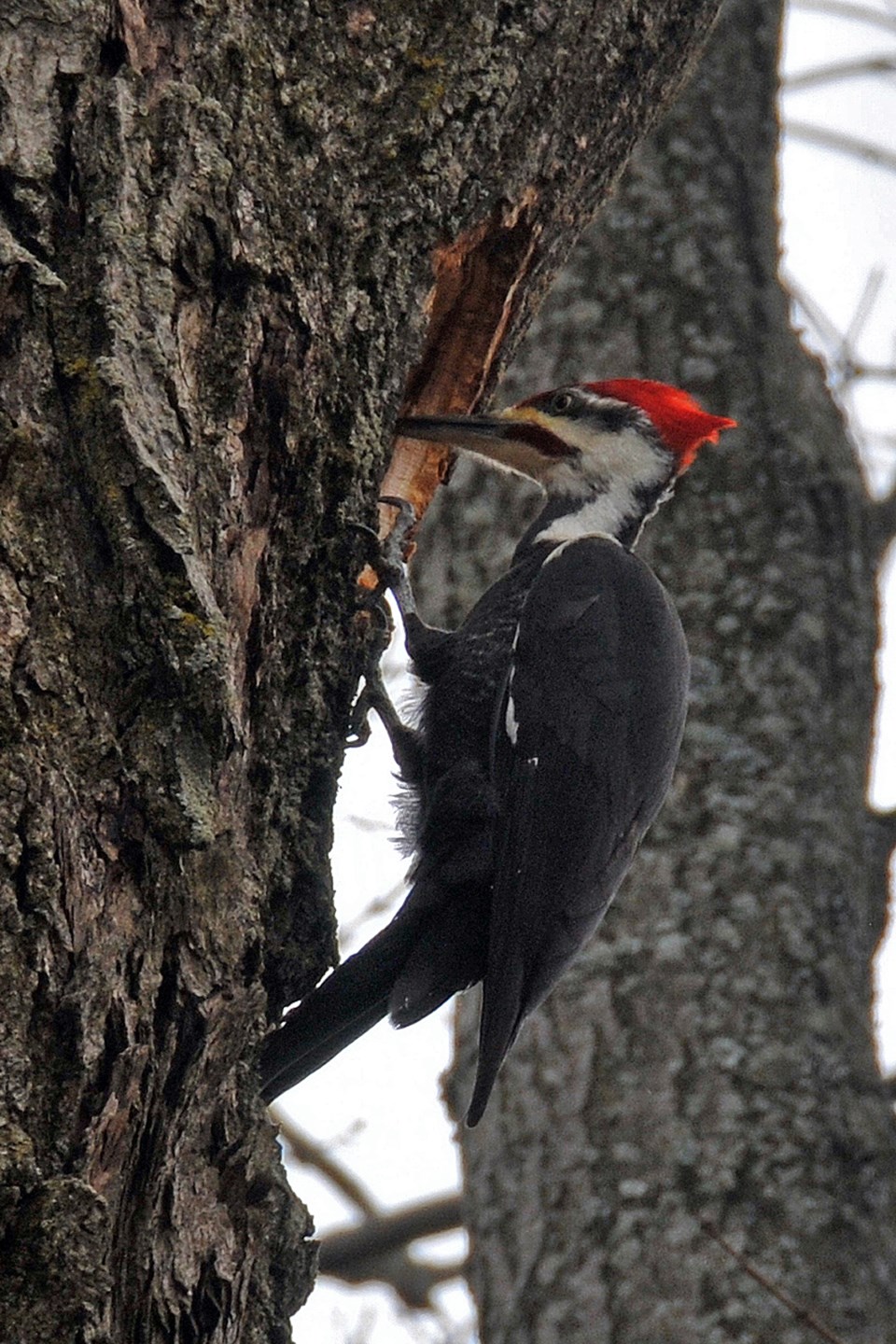Birdwatchers, whether raw amateur or seasoned professional, will all have their favourite bird species. The challenge is, as there are thousands of bird species to choose from, how does one pick an all-time favourite? Spoiler alert: you can’t!
Now perhaps you could pick ‘best duck’ or ‘best warbler’ but even that can be a bit limiting; really, how does one place a wood duck over a green-winged teal as ‘best favourite’? Even grammatically that designation is fraught with peril. (Kind of like saying, “here is the list of our Top 10 No. 1 goals.”)
I’m like that with woodpeckers. A red-headed woodpecker is way cool to see, but a close view of a male downy woodpecker with his high contrast black-and-white plumage is also rather awesome.
I’ve gotten around this best-of-the-best designation by narrowing the time frame down… to which species is my favourite for today.
And today that lucky winner of My Most Favourite Bird is a pileated woodpecker! Because there is one right outside my window, and he’s awesome.
First order of business to get the pronunciation correct… is it PILL-ee-ated or PILE-ee-ated? That may depend upon your background in the study of languages. However, my Gage Canadian Dictionary proclaims either pronunciation may be used, so it’s a tomato/ tomahto situation; whichever way makes you happy is just fine.
Within the Latin dictionary, the term ‘pileat’ means ‘capped’; so we have a woodpecker with a red cap. So far so good. Although most male woodpeckers do sport at least a red spot upon their head, only the pileated has the extraordinary crest, a real topper, a cap by any definition.
Their size is certainly an attention-grabber, being equal to a crow in wing span and body length. No slouch this one, it means business as a woodchipper. Add a sharp beak that is as long as your pointer finger, and you have an efficient gatherer of wood-boring insects.
All of our woodpeckers have the ability to swing one of their toes from front to back, thus creating an equal X formation to hold and balance on the vertical portion of a tree trunk. Add to this tail feathers that are quite strong in the shaft, and the large bird can not only rest in this vertical position, but also leverage a solid blow to the tree.
If you get the opportunity to observe an pileated hunt for food, it is quite revealing how well adapted these birds are to their role in forest management. It will and on a tree give it three or four good blows. If the resulting sound is “whack-whack-whack” it will fly away to seek another. However, if the sound is a resonating “thunk-thunk-thunk”, then meal preparation begins.
The tip of the beak is shaped much like a wood chisel, and it is forced into the rotting grain of the wood to loosen and then chip away the cellulose fiber. This takes a lot of energy, so the woodpecker won’t waste its time drilling into a solid tree, here it has heard the hollow sound of a drum, which means there are insect tunnels just below the surface bark.
If a colony of carpenter ants is revealed, the woodpecker may continue to rip open the tree trunk to a noticeable hole indeed, using its long and barbed tongue to flick ant after ant back inside its beak.
A couple of careers ago, when I worked as a civil servant at the Ministry of Natural Resources, each year a call or two would come into the office that went something like this:
Caller: There's a huge, gigantic woodpecker eating holes in my tree! Can I shoot it?
Me: Well, to me it sounds like your tree is already dying, so shooting it won't do much good.
Caller: Shooting what won't help? The tree or the woodpecker?
Me: The tree.
Caller: You stupid, over-paid, underworked, paid for with my tax-dollars civil servant!… The woodpecker! Can I shoot the woodpecker?!
Me: No.
If a pileated woodpecker is tearing your backyard tree asunder, it is because it is already dying from the inside out, and many insects have already moved in to enjoy the decaying wood.
A good gust of wind may well surprise you by snapping what you thought was a solid tree and depositing it in the swimming pool. The woodpecker gave you an early warning, allowing you to book an arbourist (“You can’t come until when??”) and start saving your money (“It’s going to cost me how much??”).
Same story with wooden telephone poles… they are good until they’re not. Pileated woodpeckers give a heads up to maintenance crews that trouble is brewing, just under the surface. So much easier to schedule a pole replacement rather than respond to an emergency call at 3 a.m. in a rain storm.
As you enjoy your winter walks, keep an eye open for signs of a pileated woodpecker doing its duty as a woodlot manger; that pile of bark and wood chips on the snow is the early warning of a dead branch overhead, courtesy of a hungry bird.
